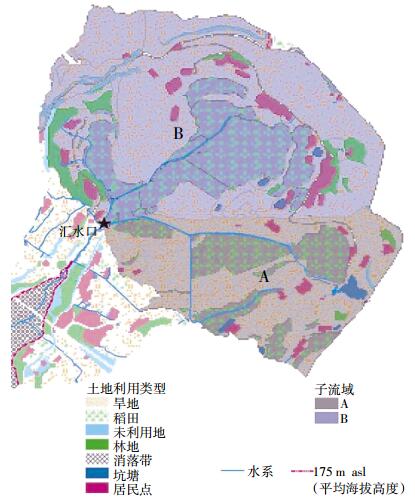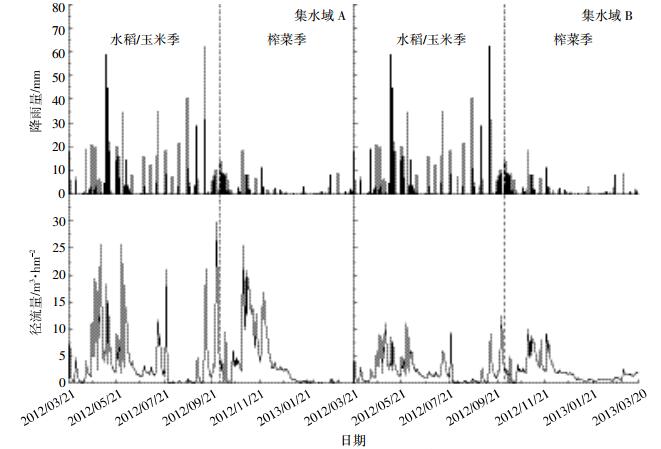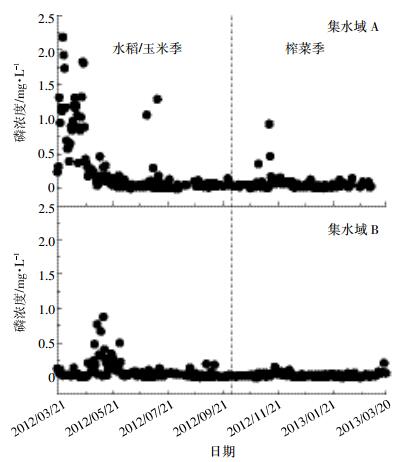文章信息
- 罗柏林, 尚二凤, 林晓, 史书, 刘园园, 倪九派, 谢德体, 木志坚
- LUO Bai-lin, SHANG Er-feng, LIN Xiao, SHI Shu, LIU Yuan-yuan, NI Jiu-pai, XIE De-ti, MU Zhi-jian
- 三峡库区不同稻田分布格局下农业小流域径流磷排放特征
- Characterization of runoff phosphorus export from small agricultural catchments with different spatial distribution patterns of rice paddies in the Three Gorges Reservoir Area
- 农业环境科学学报, 2017, 36(2): 338-344
- Journal of Agro-Environment Science, 2017, 36(2): 338-344
- http://dx.doi.org/10.11654/jaes.2016-1077
文章历史
- 收稿日期: 2016-08-18
2. 重庆市三峡库区农业面源污染控制工程技术研究中心, 重庆 北碚 400716;
3. 三峡库区生态环境教育部重点实验室, 重庆 北碚 400715
2. Engineering Research Center for Agricultural Non-point Source Pollution Control in the Three Gorges Reservoir Area, Beibei 400716, China;
3. Key Laboratory of MOE for Eco-environments in Three-Gorges Reservoir Region, Beibei 400715, China
自三峡水库蓄水以来,水环境变化显著,水体富营养化现象日趋严重[1-2]。农业生产是三峡库区农民经济收入的重要来源,该区域大部分地区化肥年平均施用量超过了500 kg·hm-2[3],高于国内平均水平(375 kg·hm-2)[4]。大量研究表明,化肥的过量施用是造成农田氮磷流失的重要原因,导致三峡库区水环境日益恶化[5-7]。目前,关于三峡库区非点源污染氮磷流失的定量化研究大多还是关于暴雨径流、短期连续采样[8-9]或以周、月为单位的间断性采样[10-12]的研究分析,具有频率低、季节单一或时间短等不足。
磷是水体富营养化的限制因子[13],主要集中于耕层,垂直下移程度很小,雨水冲刷和地表径流被认为是磷素流失的主要途径[14-16]。有研究表明,径流量与营养物质输出呈显著相关性[17-18],特别在径流系数较高的山地丘陵这种现象更加突出[19]。但影响农田氮磷流失的因素是多方面的。洪林等[20]在丘陵地区的工作与马传功等[21]的研究都发现,不同的耕作模式对地表氮磷流失量有较大影响,并随降雨强度增加而呈增加的趋势;黄东风等[22]发现,施肥和灌溉的有效搭配可以减少稻田地表径流的氮、磷流失量。这些研究主要针对的是不同耕作模式以及各类型土地利用面积比例对流域内氮磷负荷输出影响[18, 22],对另一个可能造成影响的因素--稻田空间分布格局却鲜有提及。已有研究发现[23],稻田种植面积比例对流域内径流水质有显著的影响。杨丽霞等[24]指出,稻田径流发生时间与施肥时期的间隔是决定径流磷素损失的重要因素。由此可见,稻田的存在会对流域内氮磷负荷的输出产生一定的影响。本研究选择三峡库区涪陵段王家沟小流域内两个具有相同气候、土壤耕作环境,却在稻田空间分布格局上迥异的毗邻集水域为研究对象,对两集水域汇出口径流水以及降雨进行连续一年、每日一次的高频采样监测,以期更准确地掌握集水域内径流总磷浓度动态变化以及累积排放负荷,为三峡库区农业非点源污染治理提供参考。
1 材料与方法 1.1 研究流域概况重庆涪陵珍溪镇王家沟小流域(29°54′N,107°27′E),地处涪陵东部,长江北岸,上距涪陵城区约30 km,下距丰都城约46 km,在三峡库区的腹心位置,系亚热带湿润季风气候,四季明显,多年平均气温22.1 ℃,雨量充沛,平均降雨量1011 mm。地形为低山丘陵地,海拔高度范围153~307 m。流域内坡度在40°以下,大部分区域都在20°以内,少数地区在20°~40°范围变化。土壤为侏罗系蓬莱镇组棕紫色砂泥岩相发育的棕紫泥,pH 5.6~8.1,养分除钾含量较高外,其余有机质、有效养分含量均为中等,但微量元素含量低,属中度缺乏。流域内分布有自然村落,无工矿企业,农业以人工耕作方式为主,微型机械耕作为辅,主产水稻、玉米和榨菜,构成了具有多种土地利用格局的农业生态系统。每年的土地利用方式和生产方式稳定,化肥施用是流域农田磷素输入的主要来源,平均输入P约86.6 kg·hm-2·a-1,占总输入的82.9%。每年3月底到5月中旬(玉米、水田栽种季)和10月初(榨菜栽种季)是该流域施肥期,具体情况如表 1。
利用1 m数字高程模型和arcGIS-Hydrology tools对流域内水文信息进行分析,可将该流域分为两个子集水域,标记为集水域A和B,并通过现场踏勘,结合1:1000土地利用现状图绘制该流域土地利用结构图(图 1)。该小流域总面积72.3 hm2,两集水域分别占31%、69%,皆以旱地和稻田为主,且面积比例相近,仅在稻田的空间分布格局上存在较大差异(表 2)。集水域A的稻田分布零散,集水域B的稻田连片集中在集水域底(末)端。土地破碎度指数可以反映土地利用空间结构的完整性和复杂性,破碎度越高,土地利用空间结构的完整性越低[25]。按赖彦斌等[25]的方法用单位面积上的斑块数为度量,集水域A中稻田的破碎度指数(1.74)远高于集水域B(0.19),说明集水域A中稻田分布格局的完整性远低于集水域B。

|
| 图 1 王家沟流域土地利用类型 Figure 1 Land uses in the Wangjiagou Watershed |
分别在集水域A和B的径流汇出口(图 1)安装自动采水仪(ISCO6712型,美国)和超声波水位流量计(LC-50型,中国),在2012年3月21日至2013年3月20日采集径流水样并记录流量。设置自动采水仪程序,使其在每日4:00、12:00和20:00采集等量径流水并混合作为一个时间混合水样。在自动采水仪的储水基座内放置冰袋并定期更换,使水样在低温环境下储存。每隔一定时间将水样带回实验室用钼蓝比色法测定总磷(TP):取5 mL水样加碱性过硫酸钾在121 ℃下密闭消化30 min,用紫外-可见分光光度计在880 nm波长下比色测定。此外,在小流域内还设有降雨采集装置,并结合当地气象站所提供数据,对每日的降雨量进行统计。
1.3 数据处理径流磷输出通量计算公式:
式中:L为集水域单位面积径流磷素的累积输出通量,g·hm-2;Ci为第i日径流水样的磷素浓度,mg·L-1;Qi为第i日径流水样的日径流量,m3;S为集水域面积,hm2。
径流系数计算公式:α=Y/X
式中:α为一定汇水面积内总径流量(mm)与降水量(mm)的比值;Y为总径流量,mm;X为降水量,mm。
因每季作物收获后的间歇期较短,将每季作物栽种期和随后的间歇期归为一个作物季,一并计算当季的磷素输出通量(3月底至9月中旬为水稻/玉米季;9月底至次年3月中旬为榨菜季)。
2 结果与分析 2.1 降雨量及流域汇出口径流量王家沟小流域年降雨量为970 mm,日降雨量超过50 mm的强降雨仅2 d,分别是2012年5月7日和2012年9月10日,都在水稻/玉米季,榨菜季日降雨量均小于20 mm。水稻/玉米季和榨菜季降雨量分别占全年降雨量的79.2%和20.8%(图 2)。集水域A出口日径流量在0~25.56 m3· hm-2间,全年径流系数为0.14;在水稻/玉米季施肥期的4、5月和榨菜季施肥期的10、11月出现较大的径流量,其中4、5月的径流量高于10、11月。集水域B出口日径流量0.08~12.58 m3· hm-2,全年径流系数为0.08,集水域B径流量变化规律与集水域A相似,但整体较集水域A低(图 2)。利用SPSS进行相关性分析,结果显示两集水域的径流量与降雨量存在极显著正相关关系(P < 0.01)。

|
| 图 2 流域水体日降雨和径流量情况 Figure 2 Precipitation, volume of runoff at outlets |
集水域A磷素年平均浓度约0.17 mg·L-1(图 3)。集水域A磷素高浓度值主要集中在玉米、水稻播种施肥期间的3月底至4月中旬,最高达2.18 mg·L-1,高出地表水环境质量Ⅴ类水质标准(GB 3838-2002)限值0.2 mg·L-1约10倍,虽然3-5月都是水稻/玉米季施肥阶段,但从4月下旬开始玉米地施肥活动基本结束,主要是稻田的施肥,稻田施肥量较玉米地施肥量少,且此后的降雨量也减少,在两者的综合影响下磷素浓度也随之降低;另外在6、7月的个别日期也有超过1 mg·L-1高浓度值出现,大多是在连续一段时间干旱少雨,土壤养分流失减少,随后突然迎来强降雨的日期。到了榨菜季施肥阶段,径流磷浓度再次出现升高的现象,但较水稻/玉米季浓度低,且维持时间短。

|
| 图 3 流域水体磷浓度情况 Figure 3 Temporal variations of phosphorus concentrations at outlets |
集水域B磷浓度随时间表现出与集水域A相似的变化规律(图 3),年平均浓度约0.06 mg·L-1,低于集水域A。集水域B磷浓度最高值也出现在水稻/玉米季施肥阶段。另外,集水域B磷浓度升高的三个时间段(玉米、水稻施肥期,干旱少雨后的强降雨期,榨菜施肥期)都较集水域A推迟一个月左右。
集水域A磷浓度远高于其他研究报道的三峡各农业小流域和各主要支流的平均值0.07~0.08 mg·L-1[18, 26],而集水域B则低于该平均值。
2.3 流域累积径流量和磷素输出通量王家沟小流域A、B两集水域单位面积径流磷素的累积输出通量如表 3所示。由于集水域A在径流量和磷浓度上都较集水域B高,最终导致磷素年输出通量远高出集水域B,分别为210、72 g·hm-2·a-1。两集水域在水稻/玉米季的径流磷输出通量均高于榨菜季;水稻/玉米季占年通量的70%~80%,榨菜季仅占20%~30%。

|
与王家沟相隔不远的涪陵区连丰村小流域以种植柑橘为主(园地>80%),径流磷年输出通量约为114 g·hm-2·a-1[19];三峡库区其他小流域,如云阳县活龙村小流域也是以种植柑橘为主(园地>80%),其径流磷年输出通量约为76 g·hm-2·a-1[17];秭归县兰陵溪小流域则以林地为主(>75%),但林地主要集中在高海拔地区,在海拔500 m以下超过50%为茶园,磷素年输出通量约为289 g·hm-2·a-1[27]。王家沟小流域以旱地和稻田为主,集水域B磷素年输出通量比以上三个流域都小;集水域A则比兰陵溪小流域低,但高于其他两个小流域。
3 讨论大量研究表明,流域内不同的土地利用方式及其面积比例会直接影响径流水体磷素浓度及其输出通量。曾立雄等[28]研究表明,不同土地利用类型地表径流中磷素浓度的大小依次为林地>农田>果园>茶园,但年流失负荷却表现为农田>果园>茶园>林地。同样,稻田面积比例不同也会对径流水质造成显著影响[29-30]。据宋立芳等[31]的研究,由于稻田土壤的犁底层限制了氮磷养分向深层土壤的渗漏,促使养分通过地表径流而流失,即稻田面积比例越大,氮素流失量越高。但曹志洪等[32]则指出,稻田发生的径流是“机会径流”,只有在特大的暴雨或足够大的雨量使田面水层溢出田埂时才会产生;另外,稻田水层还会对表土起到保护作用,防止雨水直接冲刷,在少雨和无雨的时间不仅养分输出减少,还对地表径流起到一定拦截作用。包珊珊等[33]在研究于桥水库流域水体氮磷空间分布与景观格局的关系时发现,流域中“汇”景观分布会影响水体养分的输出。综上所述,水田兼具“源”和“汇”两种性质:一方面稻田会释放污染物(主要在施肥期和排水晒田期);另一方面,在水稻淹水期土壤矿化作用较低且对磷有固化作用,并且土壤本身渗透性降低[34-35],水田作为一种人工湿地系统,又能对径流产生拦截作用,并持留污染物。定期维护田埂,也能降低“机会径流”的发生频次和强度,产生严重面源污染的可能性也随之降低[36]。因此,稻田系统其实是一种环境友好、生态健康的人工湿地生态系统。该结论已得到国内外学者研究实践证实[37-38]。
本研究中两个集水域位置毗邻,地理地貌、气候降雨基本一致,土壤类型、农耕方式相同,稻田比例相近。根据当地农业生产的前期资料,参考何仁江等[39]对该地区农田氮磷收支的估算结果,集水域A的单位面积土地系统化肥投入P总量约为88.5 kg·hm-2·a-1,集水域B约为85.8 kg·hm-2·a-1,两集水域相差无几。但集水域A实测径流磷素输出通量远高于集水域B,很可能是土地利用景观格局的差异造成的。一方面,集水域A中稻田破碎度指数(1.74)远高于集水域B(0.19),说明前者稻田面积分布较后者相对零散,即集水域A对径流的拦截以及磷素的净化作用不如集水域B系统和完善;另一方面,则是稻田位置分布的差异。Basnyat等[40]研究发现,当稻田作为“汇”时,距离上越靠近流域出口,其拦截净化作用就越显著。本研究中,集水域B中稻田大多沿着沟渠两侧分布,且成片集中在集水域下端地势平坦处,距离流域出口较近,这对径流水体的拦截和净化作用更加显著。综上所述,集水域B的景观格局分布,更加有效地利用了稻田作为“汇”景观的优势,最终使集水域B的径流量和磷素输出通量均明显低于集水域A。
4 结论两集水域径流量和磷浓度都表现出相似的季节性变化规律,施肥活动是造成径流水体磷浓度升高的主要原因。两集水域位置毗邻,土壤类型、性质、气候和农耕方式相同,但是由于集水域B稻田破碎度低且在集水域底端成片连接,形成了一种环境友好型“汇”景观,其累积磷输出通量仅为集水域A的三分之一,说明这类空间分布格局能更加有效的对径流水体起到拦截净化作用。因此,在农业小流域内合理地布设稻田,有助于降低径流量和磷素输出通量。
| [1] | 肖铁岩, 许晓毅, 付永川, 等. 三峡库区次级河流富营养化及其生态治理[J]. 重庆大学学报, 2009, 15(1) : 5–8. XIAO Tie-yan, XU Xiao-yi, FU Yong-chuan, et al. Discussion on the eutrophication and ecological engineering technologies for secondary rivers in the Three-Gorge Reservoir[J]. Journal of Chongqing University, 2009, 15(1) : 5–8. |
| [2] | Yang Z J, Liu D F, Ji D B, et al. Influence of the impounding process of the Three Gorges Reservoir up to water level 172.5 m on water eutrophication in the Xiangxi Bay[J]. Science China Technological Sciences, 2010, 53(4) : 1114–1125. |
| [3] | 王丽婧, 郑丙辉, 李子成. 三峡库区及上游流域面源污染特征与防治策略[J]. 长江流域资源与环境, 2009, 18(8) : 783–788. WANG Li-jing, ZHENG Bing-hui, LI Zi-cheng. Characteristics and administrative strategy of non-point source pollution in Three Gorges Reservoir and its upstream watershed[J]. Resources & Environment in the Yangtze Basin, 2009, 18(8) : 783–788. |
| [4] | 魏欣, 李世平. 基于农户行为的农业面源污染机制探析[J]. 西北农林科技大学学报:社会科学版, 2012, 12(6) : 26–31. WEI Xin, LI Shi-ping. Analysis of mechanism of agricultural non-point pollution based on farmers' production behaviors[J]. Journal of Northwest A & F University, 2012, 12(6) : 26–31. |
| [5] | Sharpley A N, Gburek W J, Folmar G, et al. Sources of phosphorus exported from an agricultural watershed in Pennsylvania[J]. Agricultural Water Management, 1999, 41(2) : 77–89. DOI:10.1016/S0378-3774(99)00018-9 |
| [6] | 孙正宝, 陈治谏, 廖晓勇, 等. 三峡库区典型小流域农业非点源氮磷流失特征[J]. 生态学杂志, 2011, 30(8) : 1720–1725. SUN Zheng-bao, CHEN Zhi-jian, LIAO Xiao-yong, et al. Characteristics of agricultural non-point source nitrogen and phosphorus losses in a typical small watershed in Three Georges Reservoir Area[J]. Chinese Journal of Ecology, 2011, 30(8) : 1720–1725. |
| [7] | 朱波, 汪涛, 王建超, 等. 三峡库区典型小流域非点源氮磷污染的来源与负荷[J]. 中国水土保持, 2010(10) : 34–36. ZHU Bo, WANG Tao, WANG Jian-chao, et al. Source and load of non-point source nitrous and phosphorus pollution of typical small watersheds in the Three Gorges Reservoir Area[J]. Soil & Water Conservation in China, 2010(10) : 34–36. |
| [8] | 张铁钢, 李占斌, 李鹏, 等. 模拟降雨条件下不同种植方式的坡地氮素流失特征[J]. 水土保持学报, 2016, 30(1) : 5–8. ZHANG Tie-gang, LI Zhan-bin, LI Peng, et al. Nitrogen loss of slope cropland unde different cropping patterns and rainfall simulation conditions[J]. Journal of Soil & Water Conservation, 2016, 30(1) : 5–8. |
| [9] | 韩黎阳, 黄志霖, 肖文发, 等. 三峡库区兰陵溪小流域土地利用及景观格局对氮磷输出的影响[J]. 环境科学, 2014, 35(3) : 1091–1097. HAN Li-yang, HUANG Zhi-lin, XIAO Wen-fa, et al. Effects of land use and landscape pattern on nitrogen and phosphorus exports in lanlingxi watershed of the Three Gorges Reservoir Area, China[J]. Acta Scientiae Circumstantiae, 2014, 35(3) : 1091–1097. |
| [10] | 高洁, 何仁江, 俞璐虹, 等. 三峡库区典型农业小流域水体水质与径流氮磷流失研究:以云阳县活龙村为例[J]. 重庆环境科学, 2012, 34(2) : 6–12. GAO Jie, HE Ren-jiang, YU Lu-hong, et al. Research on water quality and runoff loss of nitrogen and phosphorus from the typical agricultural watersheds in Three Gorges Reservoir Area:A case study in Huolong, Yunyang County[J]. Environment & Ecology in the Three Gorges, 2012, 34(2) : 6–12. |
| [11] | 张洋, 樊芳玲, 周川, 等. 三峡库区农桑配置对地表氮磷流失的影响[J]. 土壤学报, 2016, 53(1) : 189–201. ZHANG Yang, FAN Fang-ling, ZHOU Chuan, et al. Effects of crop/mulberry intercropping on surface nitrogen and phosphorus losses in Three Gorges Reservoir Area[J]. Acta Pedologica Sinica, 2016, 53(1) : 189–201. |
| [12] | 张旦麒, 何仁江, 郑军, 等. 三峡库区典型农业小流域水体水质与径流氮磷流失研究:以涪陵区连丰村为例[J]. 重庆环境科学, 2011, 33(5) : 1–5. ZHANG Dan-qi, HE Ren-jiang, ZHENG Jun, et al. Investigation on water quality and runoff loss of nitrogen and phosphorus from the typical agricultural watersheds in Three Gorges Reservoir Area:A case study in Lianfeng, Fuling District[J]. Environment & Ecology in the Three Gorges, 2011, 33(5) : 1–5. |
| [13] | Schindler D W, Hecky R E, Findlay D L, et al. Eutrophication of lakes cannot be controlled by reducing nitrogen input:Results of a 37-year whole-ecosystem experiment[J]. Proceedings of the National Academy of Sciences of the United States of America, 2008, 105(32) : 11254–11258. DOI:10.1073/pnas.0805108105 |
| [14] | Schlesinger W H, Abrahams A D, Parsons A J, et al. Nutrient losses in runoff from grassland and shrubland habitats in Southern New Mexico:Ⅰ.Rainfall simulation experiments[J]. Biogeochemistry, 1999, 45(1) : 21–34. |
| [15] | 宋林旭, 刘德富, 崔玉洁. 三峡库区香溪河流域非点源氮磷负荷分布规律研究[J]. 环境科学学报, 2016, 36(2) : 428–434. SONG Lin-xu, LIU De-fu, CUI Yu-jie. Study on the distribution of non-point nitrogen and phosphorus load from Xiangxi River in the Three Gorges Reservoir[J]. Acta Scientiae Circumstantiae, 2016, 36(2) : 428–434. |
| [16] | 陈玲, 宋林旭, 崔玉洁, 等. 模拟降雨条件下黄棕壤坡耕地磷素流失规律研究[J]. 农业环境科学学报, 2013, 32(1) : 49–55. CHEN Ling, SONG Lin-xu, CUI Yu-jie, et al. Characteristics of phosphorus loss in sloping arable land of Yellow-brown soil under artificial rainfall test[J]. Journal of Agro-Environment Science, 2013, 32(1) : 49–55. |
| [17] | 徐畅, 谢德体, 高明, 等. 三峡库区小流域旱坡地氮磷流失特征研究[J]. 水土保持学报, 2011, 25(1) : 1–5. XU Chang, XIE De-ti, GAO Ming, et al. Study on the nitrogen and phosphorus loss characteristics from sloping uplands in small watershed of Three Gorges Reservoir Region[J]. Journal of Soil & Water Conservation, 2011, 25(1) : 1–5. |
| [18] | 李瑞玲, 张永春, 刘庄, 等. 太湖缓坡丘陵地区雨强对农业非点源污染物随地表径流迁移的影响[J]. 环境科学, 2010, 31(5) : 1220–1226. LI Rui-ling, ZHANG Yong-chun, LIU Zhuang, et al. Rainfall intensity effects on nutrients transport in surface runoff from farmlands in gentle slope hilly area of Taihu Lake Basin[J]. Environmental Science, 2010, 31(5) : 1220–1226. |
| [19] | 王克勤, 宋泽芬, 李太兴, 等. 抚仙湖一级支流尖山河小流域的面源污染物贡献特征[J]. 环境科学学报, 2009, 29(6) : 1321–1328. WANG Ke-qin, SONG Ze-fen, LI Tai-xing, et al. The contribution of non-point pollution in the Jianshan River watershed, the first branch of Fuxian Lake[J]. Acta Scientiae Circumstantiae, 2009, 29(6) : 1321–1328. |
| [20] | 洪林, 李瑞鸿. 南方典型灌区农田地表径流氮磷流失特性[J]. 地理研究, 2011, 30(1) : 115–124. HONG Lin, LI Rui-hong. Characteristics of nitrogen and phosphorus losses in surface runoff from farmland in a typical irrigation district in Southern China[J]. Geographical Research, 2011, 30(1) : 115–124. |
| [21] | 马传功, 陈建军, 郭先华, 等. 坡耕地不同种植模式对农田水土保持效应及土壤养分流失的影响[J]. 农业资源与环境学报, 2016, 33(1) : 72–79. MA Chuan-gong, CHEN Jian-jun, GUO Xian-hua, et al. Effects of different cropping patterns on soil and water conservation benefits and soil nutrients loss on sloping land[J]. Journal of Agricultural Resources and Environment, 2016, 33(1) : 72–79. |
| [22] | 黄东风, 李卫华, 王利民, 等. 水肥管理措施对水稻产量、养分吸收及稻田氮磷流失的影响[J]. 水土保持学报, 2013, 27(2) : 62–66. HUANG Dong-feng, LI Wei-hua, WANG Li-min, et al. Effects of water and fertilizer managements on yield, nutrition uptake of rice and of nitrogen and phosphorus loss of runoff from paddy field[J]. Journal of Soil & Water Conservation, 2013, 27(2) : 62–66. |
| [23] | 夏小江.太湖地区稻田氮磷养分径流流失及控制技术研究[D].南京:南京农业大学, 2012. XIA Xiao-jiang. Study on nitrogen and phosphorus runoff losses from paddy field and control technology in Tai Lake Area[D]. Nanjing:Nanjing Agricultural University, 2012. |
| [24] | 杨丽霞, 杨桂山. 施磷对太湖流域水稻田磷素径流流失形态的影响[J]. 水土保持学报, 2010, 24(5) : 31–34. YANG Li-xia, YANG Gui-shan. Effects of phosphorus application on P forms in runoff from rice field of Taihu Watershed[J]. Journal of Soil & Water Conservation, 2010, 24(5) : 31–34. |
| [25] | 赖彦斌, 徐霞, 王静爱, 等. NSTEC不同自然带土地利用/覆盖格局分析[J]. 地球科学进展, 2002, 17(2) : 215–220. LAI Yan-bin, XU Xia, WANG Jing-ai, et al. Analysis of lucc pattern on physical region in NSTEC[J]. Advance in Earth Sciences, 2002, 17(2) : 215–220. |
| [26] | 张远, 郑丙辉, 刘鸿亮, 等. 三峡水库蓄水后氮、磷营养盐的特征分析[J]. 水资源保护, 2005, 21(6) : 23–26. ZHANG Yuan, ZHENG Bing-hui, LIU Hong-liang, et al. Characters of nitrogen and phosphorus of the Three Gorges Reservoir after impounding[J]. Water Resources Protection, 2005, 21(6) : 23–26. |
| [27] | 曾立雄, 肖文发, 黄志霖, 等. 三峡库区兰陵溪小流域养分流失特征[J]. 环境科学, 2013, 34(8) : 3035–3042. ZENG Li-xiong, XIAO Wen-fa, HUANG Zhi-lin, et al. Characteristics of nutrient loss of Lanlingxi Watershed in the Three Gorges Reservoir Area[J]. Environmental Science, 2013, 34(8) : 3035–3042. |
| [28] | 曾立雄, 黄志霖, 肖文发, 等. 三峡库区不同土地利用类型氮磷流失特征及其对环境因子的响应[J]. 环境科学, 2012, 33(10) : 3390–3396. ZENG Li-xiong, HUANG Zhi-lin, XIAO Wen-fa, et al. Nitrogen and phosphorus loss in different land use types and its response to environmental factors in the Three Gorges Reservoir Area[J]. Environmental Science, 2012, 33(10) : 3390–3396. |
| [29] | 罗璇, 史志华, 尹炜, 等. 小流域土地利用结构对氮素输出的影响[J]. 环境科学, 2010, 31(1) : 58–62. LUO Xuan, SHI Zhi-hua, YIN Wei, et al. Effects of land use structure on nitrogen export in Hujiashan Watershed of Danjiangkou Reservoir Area, China[J]. Environmental Science, 2010, 31(1) : 58–62. |
| [30] | 祝惠, 阎百兴. 三江平原水田氮的侧渗输出研究[J]. 环境科学, 2011, 32(1) : 108–112. ZHU Hui, YAN Bai-xing. Export of nitrogen by lateral seepage from paddy field in Sanjiang Plain[J]. Environmental Science, 2011, 32(1) : 108–112. |
| [31] | 宋立芳, 王毅, 吴金水, 等. 水稻种植对中亚热带红壤丘陵区小流域氮磷养分输出的影响[J]. 环境科学, 2014, 35(1) : 150–156. SONG Li-fang, WANG Yi, WU Jin-shui, et al. Impact of rice agriculture on nitrogen and phosphorus exports in streams in Hilly Red Soil Earth Region of central subtropics[J]. Environmental Science, 2014, 35(1) : 150–156. |
| [32] | 曹志洪, 林先贵, 杨林章, 等. 论"稻田圈"在保护城乡生态环境中的功能:Ⅰ.稻田土壤磷素径流迁移流失的特征[J]. 土壤学报, 2005, 42(5) : 799–804. CAO Zhi-hong, LIN Xian-gui, YANG Lin-zhang, et al. Ecological function of "paddy field ring" to urban and rural environment:Ⅰ.Characteristics of soil P losses from paddy fields to waterbodies with runoff[J]. Acta Pedologica Sinica, 2005, 42(5) : 799–804. |
| [33] | 包姗姗, 李崇巍, 王祖伟, 等. 天津于桥水库流域水体氮磷空间分异与景观格局的关系[J]. 农业环境科学学报, 2014, 33(8) : 1609–1616. BAO Shan-shan, LI Chong-wei, WANG Zu-wei, et al. Relationship between spatial variation of nitrogen and phosphorus in Water and Landscape Pattern in Yuqiao Reservoir Basin, Tianjin[J]. Journal of Agro-Environment Science, 2014, 33(8) : 1609–1616. |
| [34] | 许晓光, 李裕元, 孟岑, 等. 亚热带区稻田土壤氮磷淋失特征试验研究[J]. 农业环境科学学报, 2013, 32(5) : 991–999. XU Xiao-guang, LI Yu-yuan, MENG Cen, et al. The characteristics of nitrogen and phosphorus leaching in a paddy soil in subtropics[J]. Journal of Agro-Environment Science, 2013, 32(5) : 991–999. |
| [35] | Linquist B A, Ruark M D, Hill J E. Soil order and management practices control soil phosphorus fractions in managed wetland ecosystems[J]. Nutrient Cycling in Agroecosystems, 2011, 90(1) : 51–62. DOI:10.1007/s10705-010-9411-3 |
| [36] | 曹志洪, 林先贵, 杨林章, 等. 论"稻田圈"在保护城乡生态环境中的功能:Ⅱ稻田土壤氮素养分的累积、迁移及其生态环境意义[J]. 土壤学报, 2006, 43(2) : 256–260. CAO Zhi-hong, LIN Xian-gui, YANG Lin-zhang, et al. Ecological function of "paddy field ring" to urban and rural environment:Ⅱ.Characteristics of soil p losses from paddy fields to waterbodies with runoff[J]. Acta Pedologica Sinica, 2006, 43(2) : 256–260. |
| [37] | Greenland D J. The sustainability of rice farming[D]. London:CAB International Publication in Association with the International Rice Research Institute, 1998:110-113. |
| [38] | Yan W, Yin C, Tang H. Nutrient retention by multipond systems:Mechanisms for the control of nonpoint source pollution[J]. Journal of Environmental Quality, 1998, 27(5) : 1009–1017. |
| [39] | 何仁江, 江韬, 木志坚, 等. 三峡库区典型农业小流域土壤系统氮磷收支研究[J]. 西南大学学报, 2011, 33(5) : 95–101. HE Ren-jiang, JIANG Tao, MU Zhi-jian, et al. Nitrogen and phosphorus balance for the soil systems in a typical small agricultural watershed in the Three-Gorges Reservoir Area[J]. Journal of Southwest University, 2011, 33(5) : 95–101. |
| [40] | Basnyat P, Teeter L D, Flynn K M, et al. Relationships between landscape characteristics and nonpoint source pollution inputs to coastal estuaries[J]. Environmental Management, 1999, 23(4) : 539–549. DOI:10.1007/s002679900208 |
 2017, Vol. 36
2017, Vol. 36






